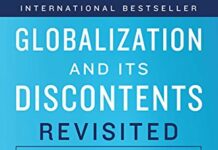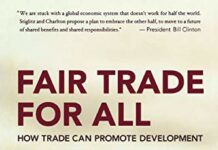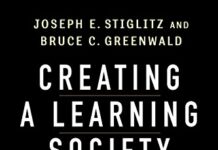
Ebook Info
- Published: 2012
- Number of pages: 449 pages
- Format: PDF
- File Size: 2.71 MB
- Authors: Joseph E. Stiglitz
Description
A forceful argument against America’s vicious circle of growing inequality by the Nobel Prize–winning economist.The top 1 percent of Americans control some 40 percent of the nation’s wealth. But as Joseph E. Stiglitz explains in this best-selling critique of the economic status quo, this level of inequality is not inevitable. Rather, in recent years well-heeled interests have compounded their wealth by stifling true, dynamic capitalism and making America no longer the land of opportunity that it once was. They have made America the most unequal advanced industrial country while crippling growth, distorting key policy debates, and fomenting a divided society. Stiglitz not only shows how and why America’s inequality is bad for our economy but also exposes the effects of inequality on our democracy and on our system of justice while examining how monetary policy, budgetary policy, and globalization have contributed to its growth. With characteristic insight, he diagnoses our weakened state while offering a vision for a more just and prosperous future.
User’s Reviews
Reviews from Amazon users which were colected at the time this book was published on the website:
⭐The Price of Inequality: How Today’s Divided Society Endangers Our Future by Joseph E. Stiglitz “The Price of Inequality” is one of the most compelling economic books about the excessive inequality in the United States. It does a fabulous job of explaining three interlinking themes: that inequality is cause and consequence of the failure of the political system, and contributes to the instability of our economic system, which in turns contributes to inequality. Winner of the 2001 Nobel Memorial Prize for Economics and acclaimed professor and author, Joseph Stiglitz, provides the reader with a quote-fest of a book that addresses not only the reasons for such a financial divide but provides pragmatic economical ways to tackle them. This enlightening and pragmatic 449-page book is composed of the following ten chapters: 1. America’s 1 Percent Problem, 2. Rent Seeking and the Making of an Unequal Society, 3. Markets and Inequality, 4. Why It Matters, 5. A Democracy in Peril, 6. 1984 Is Upon Us, 7. Justice for All? How Inequality is Eroding the Rule of Law, 8. The Battle of the Budget, 9. A Macroeconomic Policy and a Critical Bank By and for the 1 Percent and 10. The Way Forward: Another World Is Possible.Positives:1. A well-written page-turner of a book that is accessible to the masses. A quote fest.2. It’s always a treat to read a book from an expert who knows what he is talking about and how to relay it to the public.3. Great format. The author starts each of the ten chapters with a quick synopsis and closes out with concluding comments.4. This book succeeds in getting to the heart of the thesis: why inequality is growing to the extent it is and what the consequences are. Stiglitz is relentless in his pursuit and we are the beneficiaries.5. Why are economic system is unfair? Answered to satisfaction. Eye-opening information.6. “While there may be underlying forces at play, politics have shaped the market, and shaped it in ways that advantage the top at the expense of the rest”. It’s a quote fest alright.7. The 1 percent in perspective. ” For an even more striking illustration of the state of inequality in America, consider the Walton family: the six heirs to the Wal-Mart empire command wealth of $69.7 billion, which is equivalent to the wealth of the entire bottom 30 percent of U.S. society. The numbers may not be as surprising as they seem, simply because those at the bottom have so little wealth”.8. How government policies shape inequality. “A major theme of this book is that inequality is the result of political forces as much as of economic ones”.9. There is so many mind-blowing facts in this book, ” A little-noticed change in legislation, for example, can reap billions of dollars. This was the case when the government extended a much-needed Medicare drug benefit in 2003. A provision in the law that prohibited government from bargaining for prices on drugs was, in effect, a gift of some $50 billion or more per year to the pharmaceutical companies”. Oh yeah, it’s like that.10. How societal norms shape inequality. How globalization as it has been managed contributes to inequality. Interesting stuff.11. The true role of government and how our government failed the 99%. “The United States spent far more on its big bank bailout, which helped the banks to maintain their generous bonuses, than it spent to help those who were unemployed as a result of the recession that the big banks brought about. We created for the banks (and other corporations, like AIG) a much stronger safety net than we created for poor Americans”.12. The effects of inequality on national output and economic stability, and its impact on economic efficiency and on growth.13. Some very key points that will stick with me, “The 2010 decision in the case of Citizens United v. Federal Election Commission, in which the Supreme Court essentially approved unbridled corporate campaign spending, represented a milestone in the disempowerment of ordinary Americans”. A need to reform our political process.14. How the 1 percent convinces the 99 percent that they have shared interests. It’s about shaping perceptions.15. The battle over laws and regulations that govern our economy and how they are enforced. How the powerful have turned America’s legal system into a travesty of justice.16. A great section on predatory lending. How the banks won at the expense of America. And an infuriating section on student loans.17. How surpluses under Clinton were turned to deficits under the influence of four major forces. The budget in perspective.18. Practical recommendations to reduce the deficit. “lowering the taxes on firms that created jobs and invested in America and raising taxes on those that didn’t”.19. A section on debunking myths: the supply-side myth, the raising taxes on millionaires will hurt small businesses and therefore cost jobs myth, the government-run programs must be inefficient myth, blame the poor myth, the austerity myth, and the failed stimulus myth.20. Understanding the real role of policy makers. “A central theme of the book is that some of the policy choices have simultaneously increased inequality, benefitting those at the top– and hurt the economy”.21. “The Fed gambled, in trusting that banks on their own could manage risk–a gamble that paid off handsomely for the banks, and especially for the bankers, but in which the rest paid the price. The Fed could have curbed the reckless and predatory lending, the abusive credit card practices, but chose not to do so. Again, the banks were the winners; the rest the losers”. I just can’t word that any better.22. The obsession with inflation. A good section.23. Ending on a positive note. ” This book is not about the politics of envy: the bottom 99 percent by and large are not jealous of the social contributions that some of those among the 1 percent have made, of their well-deserved incomes. This book is instead about the politics of efficiency and fairness. The central argument is that the model that best describes income determination at the top is not one based on individuals’ contributions to society (the “marginal productivity theory” introduced earlier), even though, of course, some at the top have made enormous contributions. Much of the income at the top is instead what we have called rents”.24. A list of recommendations in narrative format that shows what needs to be done to create reforms we need in our economics and our politics.25. A comprehensive notes section.Negatives:1. The strength of this book is clearly explaining how we got to this level of inequality, the biggest weakness is the level of the cure not necessarily matching the disease. I feel that the recommendations covered in this book are good, it just doesn’t live up to the diagnosis. I also disagree with a few of the recommendations. Getting the marginal tax back to 70% seems unfair even to this progressive-minded reviewer.2. A little repetitive.3. Some of the material in this book will make your blood boil.4. Charts and illustrations would have added value.5. The notes section was very comprehensive but a formal bibliography never hurts.In summary, this is a fantastic book. I really enjoyed it. Stiglitz has a great command of the topic and is able to convey his thoughts in a lucid an accessible manner. His arguments are sound and quite compelling and backed by countless references. If you want to learn how we got to this level of inequality, this is a fantastic book that covers it with expertise. I highly recommend it!Further suggestions: ”
⭐” by David Wessel, ”
⭐” by Bruce Bartlett, ”
⭐” by James Carville and Stan Greenberg, ”
⭐” by Paul Krugman, ”
⭐” by Robert B. Reich, ”
⭐” by Chris Mooney, ”
⭐” by Jacob S. Hacker, ”
⭐” by Thom Hartmann, ”
⭐” by Michael W. Hudson, “Perfectly Legal…” by David Cay Johnston, and “The Looting of America” by Les Leopold.
⭐Joseph Stiglitz is one of the greatest economists of our time, a Nobel Prize winner, former head of the World Bank and Chairman of the President’s Council of Economic Advisors. He is also seriously concerned about poverty and inequality in America. I remember well hearing him on NPR radio being interviewed on the day he was informed that he was awarded the 2001 Nobel Prize in Economics: he spoke passionately and almost exclusively about the need for eradicating poverty in America and around the world.The economic argument for policies that favor the poor over the rich are very simple, being based on the universally accepted principle of the declining marginal utility of income. What that means is that one dollar is worth a lot more to a person who makes $20,000 a year than it is to a person who makes $200,000 a year. Thus a policy that gives $1 to the poorer and reduces the income of the richer by the same amount will increase general social welfare. Some people have argued that this is a value judgment rather than a fact, but that is just wrong. It is a fact, pure and simple.The bottom half of the income distribution in America earns only 12% of total income. Why don’t they just vote to take money from the top 1% of earners, who capture about 20% of total income? If voters took away half of the earnings of the top 1% and gave it to the bottom 50%, each recipient household would receive about $14,000, a not insignificant sum.I do not know why voters do not expropriate the rich (both supporters and opponents in the Eighteenth and Nineteenth centuries certainly expected that to happen upon the advent of democracy with universal suffrage), but there is one strong arguments against expropriating the rich: to the extent that high incomes motivate the talented to acquire and exercise skills and to take risks, excessive taxation will lead to economic stagnation.In fact, my observation of American politics leads me to a very simple understanding of voter sentiments: people care about injustice but not about inequality. The current wave of anger at the top 1% is not fueled by resentment against inequality, but rather against the injustice of the people at the top gaining while others are losing jobs and houses due to the economic elite’s anti-social and greedy machinations.There are of course societies where people care about inequality per se. But those are invariably relatively poor, clannish societies. For instance, in hunter-gatherer societies without forms of material wealth, when one family is very successful, others who are less successful will demand sharing the bounty. This of course eliminates the incentive to be successful and entails enduring social poverty of the group. In rich societies such as our own, people are used to congratulating the successful, whether sports stars, movie stars, real estate wheeler-dealers, and other celebrities. People object only when they feel success was based on some form of injustice, or the well-off are behaving uncharitably. Inequality per se is simply not something people think is wrong (except, of course, for a fringe of super-liberals, who are politically irrelevant).Stiglitz draws precisely on this sentiment in this spirited call to action for income redistribution towards the less well off. Recounting the well-established fact that the very rich have done extremely well in the past few decades while the fortunes of those below the top 10% have stagnated, Stiglitz argues that the good fortune of the winners is indeed unjust, being a reward for their inveterate rent-seeking rather that their contributions to society. Stiglitz writes: “This book is not about the politics of envy: the bottom 99 percent by and large are not jealous of the social contributions that some of those among the 1 percent have made, of their well-deserved incomes. This book is instead about the politics of efficiency and fairness. The central argument is that the model that best describes income determination at the top is not one based on individuals’ contributions to society… Much of the income at the top is instead what we have called rents. These rents have moved dollars from the bottom and middle to the top…In the United States the “Occupy Wall Street” movement echoed the same refrain. The unfairness of a situation in which so many lost their homes and their jobs while the bankers enjoyed large bonuses was grating.”Stiglitz recognizes that because the increase in inequality is due to rent-seeking rather than inexorable “market forces,” it can be reversed by ending the rent-seeking—in effect by changing tax laws. He writes “while we may be able to do only a little to change the direction of market forces, we can circumscribe rent seeking. Or at least we could, if we managed to get our politics right.” Much of the book consists of suggestions to this end. These include curbing the financial sector, stronger pro-competition and anti-trust laws, limiting the power of CEOs, eliminate “corporate welfare” in the form of subsidies to privileged sectors of the economy, improve access to education, institute comprehensive and universal health care, follow a vigorous full-employment fiscal policy, expand affirmative action for minorities, and restore the power of workers’ unions.Perhaps Stiglitz’ most ambitious suggestion is his proposal for curbing the inegalitarian effects of globalization. He writes, “Globalization and technology both contribute to the polarization of our labor market, but they are not abstract market forces that just arrive from on high; rather, they are shaped by our policies. We have explained how globalization— especially our asymmetric globalization—is tilted toward putting labor in a disadvantageous bargaining position vis-à-vis capital. While globalization may benefit society as a whole, it has left many behind— not a surprise given that, to a large extent, globalization has been managed by corporate and other special interests for their benefit. Too often, the response to the threat of globalization is to make workers even worse off, not just by cutting their wages but also by lowering social protections. The growth of the antiglobalization movement is, under these circumstances, totally understandable. There are myriad ways in which globalization could be brought back into a better balance.”It strikes me that Stiglitz’ analysis and his policy recommendations are closely tailored to what progressive Democrats in America are thinking, and to what seasoned politicians believe it is possible to attain politically. However, and while I fully agree with many of his policy recommendations, I disagree with some crucial recommendations, and there are important policy options that he does not discuss.Most important, I think it is likely that the increase in before-tax inequality that we have experienced in the past few decades is in fact market-driven rather than rent-seeking-driven. This is because there are similar trends in all the advanced market economies, the increases in income accrue to members of high-skilled professions, such as law, medicine, and management, and the most income-skewed sector, finance, as grown exponentially through increased public demand for financial services. I should note that Stiglitz himself admits that his rent-seeking thesis is more or less untenable, and he accepts it for reasons of personal taste. He writes: “It is essentially impossible to single out any one factor’s relative contribution, given how intertwined the various forces shaping inequality are; there can be honest differences of opinion. But… markets don’t exist in a vacuum. They are shaped by our politics, often in ways that benefit those at the top. Moreover, while we may be able to do only a little to change the direction of market forces, we can circumscribe rent seeking. Or at least we could, if we managed to get our politics right.”This admonition reminds me of the old saw about the economist looking for his lost keys one evening under a lamppost despite the fact that he dropped them in the bushes, explaining that there is more light under the lamppost. More to the point: if the problem isn’t rent-seeking, then you can’t reverse it by curbing rent-seeking! It would be more plausible to say that before-tax income inequality has been caused by market forces, but could be corrected by higher taxes on the rich (think of avoiding taxation as a form of rent-seeking). The problem is that the well-off already pay most of the taxes. The top 5% of the income distribution, who receive 45% of national income, pay 71% of all federal income taxes, while the bottom 50%, who receive 12% of national income, pay only 2% of all federal income taxes. There is not likely much leeway for increasing tax rates on the rich much more without generating very strong tendencies for tax avoidance and reduced economic participation of the economic elite.Another indication of Stiglitz’ adherence to the agenda of the Democratic Party is his pandering to unions. Public sector unions are especially great contributors to the Democratic Party coffers, but it is not clear that they are in any way a force for the mitigation of inequality. Take for instance the teachers’ unions, which are inveterately hostile to competition in education, and which must be pulled kicking and dragging even to allow the firing of incompetent teachers. Stiglitz repeats several times in the book that teachers are underpaid, but never mentions the fact that incentive pay is virtually impossible without serious educational reform. He does not include charter schools or education voucher plan in his recommendation for progressive policy reform.I have an alternative vision for progressive reform in America. It is not predicated on redistribution through tax laws, strong unions, or crippling the power of business and banking leaders. It is through what Samuel Bowles and I have called “productivity enhancing redistributions” (PEDs) These are policies that both improve the productivity of the economy and at the same time materially benefit the less-well-off. To the extent that a more competitive educational system contributes to the work skills and attitudes of poor youth, it is a productivity enhancing redistribution. The Earned Income Tax Credit (EITC) is a productivity enhancing redistribution, as are on-the-job apprenticeship programs, support for some forms of job retraining, and support for community health programs. Probably most such policy endeavors can be implemented without increasing tax rates.Perhaps the political types are correct in believing that productivity enhancing redistribution are not politically feasible, but I cannot imagine why not.
⭐Stiglitz’s message, debunking neoliberalism and austerity, is an excellent one. So are his explanations of the dangers of inequality from both an economic and social point of view, particularly the failure it is indicative of with regard to democracy and the rule of law and the threats it represents to both. Encouragingly, he also offers cogent solutions. This is such an important book that it is a great pity it is so poorly written. It is replete with long-winded and complex sentences, annoying repetition and unexplained assertions that appear to have been tossed into sentences simply for good measure. I challenge anyone to absorb an entire chapter without putting the book down a number of times out of exasperation. This is a book that deserves the widest of audiences; but, sadly, it will not get it.
⭐I’ve read several books critiquing todays global capitalist market based economy, and I have to say that although Stiglitz brings up a tonne of excellent points, its worth noting his delivery of them is usually quite lax. I feel in efforts to simplify a lot of the text for the average reader, a lot of key details in certain anecdotes are left out and relegated to the notes section at the back (which ends up being more than 1/3rd of the book). On the other hand, several areas were difficult to to comprehend given the jargon used (many jargon terms were used extensively for a few chapters, only to be eventually defined way later in the book).In addition, like most other books, there is very little detail given to possible solutions to the crisis. Its very easy to criticise something for 300 pages, but if you plan on doing so you should at least give some serious effort to the solutions you would present-more than just a small chapter at the end!Also worth noting that this book was written in 2012, given the 2016 presidential campaign and messaging by both parties since, some of the points are actually inaccurate (like when he mentioned that even the slightest whiff of expanding medicare would be enough to end a Democratic campaign). But if you are interested in that, or are willing to sit through it for what is overall an excellent description of many of the problems behind the last recession and those before it, check this book out
⭐Since the US is further ahead in the destruction of the welfare state than the UK, it is not surprising that the most trenchant criticisms have come from there. Stiglitz is no wild-eyed radical. A nobel laureate for economics who served in the Clinton administration, he gives a very clear and well-documented critique of the drive to austerity.In assessing the rich 1%, he differentiates wealth gained from ‘rent-taking’ from other forms. This, he argues, is simply money taken out of the economy. That this wealth enriches everyone by a ‘trickle-down’ process he exposes as a myth. It simply hasn’t happened.CEO’s of large companies have increasingly enriched themselves by huge bonuses as ‘incentive payments’ when any rise in profits is outside of their control. And they have not taken any corresponding hit when the market slumped during the recession. Money from taxation has been handed out in the form of hidden subsidies to large companies in many ways, not least in the bank bailouts, whilst aid to the poor has been cut. And yet, because the poorest in society spend most or all of their money by necessity, boosting the pay of the poorest is the best way of increasing demand in society and helping economic recovery.Tax cuts for the rich do not increase the total amount of tax received by the government, as is often claimed. The historical record in the US since the Reagan administration show that this simply did not happen.I will not attempt to precis the contents of the book any further. I think this book is an essential read to understand why the ideological attack on the welfare state makes life so much worse for the majority of people, not just those on benefits.
⭐Disturbing attack on today’s capitalism and world’s elites who the author says create establishments that ensure thet they keep the power and the money forever. And it is a pretty convincing argument. Sadly, Dr Stiglitz spends much time making his case that there is indeed inequality and far too little time laying out a plan for a better method of governance in the West.
⭐The strengths of this book include highlighting the erosion of equality over time and some stark comparrisons to how inequality is better or similar to equality earlier in (recent) history.This is a good book.As a minor point, I feel that a few aspects of it have moved on (which is understandable since I read it 7-8 years after publication).Specifically, I think that we have a better/broader understanding of some of the aspects relating to the GFC, but I was happy to skip past these parts and appreciate its strength is inequality.
Keywords
Free Download The Price of Inequality: How Today’s Divided Society Endangers Our Future in PDF format
The Price of Inequality: How Today’s Divided Society Endangers Our Future PDF Free Download
Download The Price of Inequality: How Today’s Divided Society Endangers Our Future 2012 PDF Free
The Price of Inequality: How Today’s Divided Society Endangers Our Future 2012 PDF Free Download
Download The Price of Inequality: How Today’s Divided Society Endangers Our Future PDF
Free Download Ebook The Price of Inequality: How Today’s Divided Society Endangers Our Future





